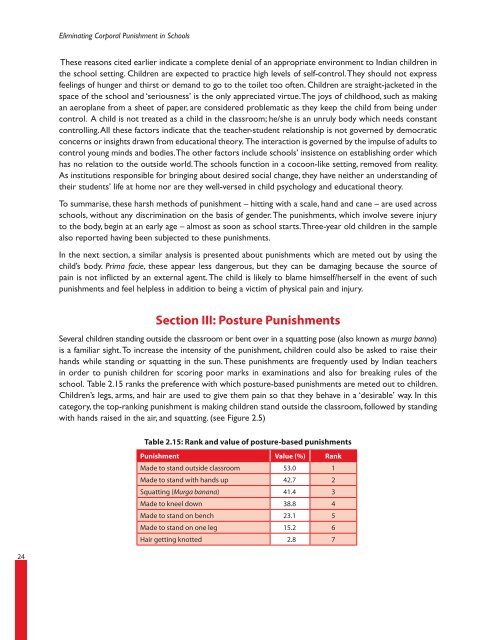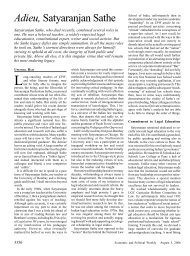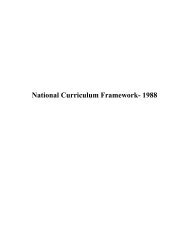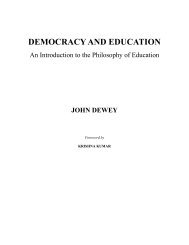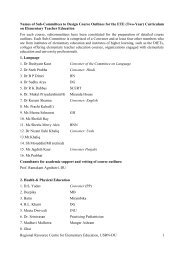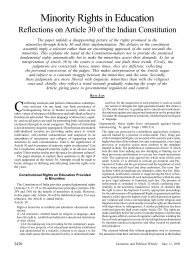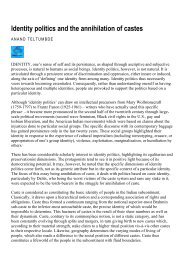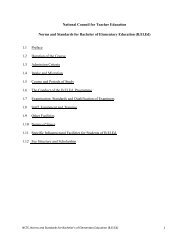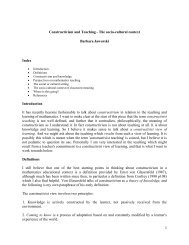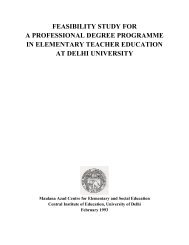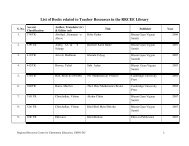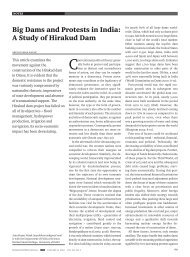Corporal Punishment - Eledu.net
Corporal Punishment - Eledu.net
Corporal Punishment - Eledu.net
Create successful ePaper yourself
Turn your PDF publications into a flip-book with our unique Google optimized e-Paper software.
Eliminating <strong>Corporal</strong> <strong>Punishment</strong> in SchoolsThese reasons cited earlier indicate a complete denial of an appropriate environment to Indian children inthe school setting. Children are expected to practice high levels of self-control. They should not expressfeelings of hunger and thirst or demand to go to the toilet too often. Children are straight-jacketed in thespace of the school and ‘seriousness’ is the only appreciated virtue. The joys of childhood, such as makingan aeroplane from a sheet of paper, are considered problematic as they keep the child from being undercontrol. A child is not treated as a child in the classroom; he/she is an unruly body which needs constantcontrolling. All these factors indicate that the teacher-student relationship is not governed by democraticconcerns or insights drawn from educational theory. The interaction is governed by the impulse of adults tocontrol young minds and bodies. The other factors include schools’ insistence on establishing order whichhas no relation to the outside world. The schools function in a cocoon-like setting, removed from reality.As institutions responsible for bringing about desired social change, they have neither an understanding oftheir students’ life at home nor are they well-versed in child psychology and educational theory.To summarise, these harsh methods of punishment – hitting with a scale, hand and cane – are used acrossschools, without any discrimination on the basis of gender. The punishments, which involve severe injuryto the body, begin at an early age – almost as soon as school starts. Three-year old children in the samplealso reported having been subjected to these punishments.In the next section, a similar analysis is presented about punishments which are meted out by using thechild’s body. Prima facie, these appear less dangerous, but they can be damaging because the source ofpain is not inflicted by an external agent. The child is likely to blame himself/herself in the event of suchpunishments and feel helpless in addition to being a victim of physical pain and injury.Section III: Posture <strong>Punishment</strong>sSeveral children standing outside the classroom or bent over in a squatting pose (also known as murga banna)is a familiar sight. To increase the intensity of the punishment, children could also be asked to raise theirhands while standing or squatting in the sun. These punishments are frequently used by Indian teachersin order to punish children for scoring poor marks in examinations and also for breaking rules of theschool. Table 2.15 ranks the preference with which posture-based punishments are meted out to children.Children’s legs, arms, and hair are used to give them pain so that they behave in a ‘desirable’ way. In thiscategory, the top-ranking punishment is making children stand outside the classroom, followed by standingwith hands raised in the air, and squatting. (see Figure 2.5)Table 2.15: Rank and value of posture-based punishments<strong>Punishment</strong> Value (%) RankMade to stand outside classroom 53.0 1Made to stand with hands up 42.7 2Squatting (Murga banana) 41.4 3Made to kneel down 38.8 4Made to stand on bench 23.1 5Made to stand on one leg 15.2 6Hair getting knotted 2.8 724


